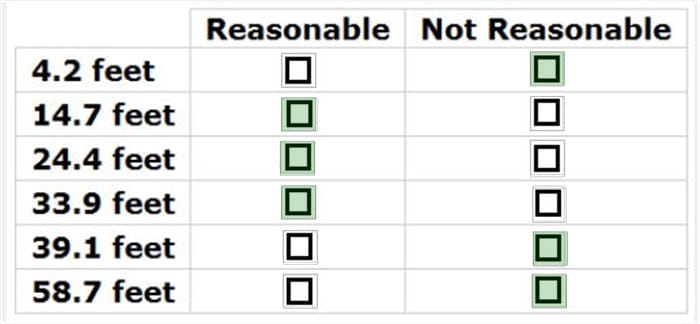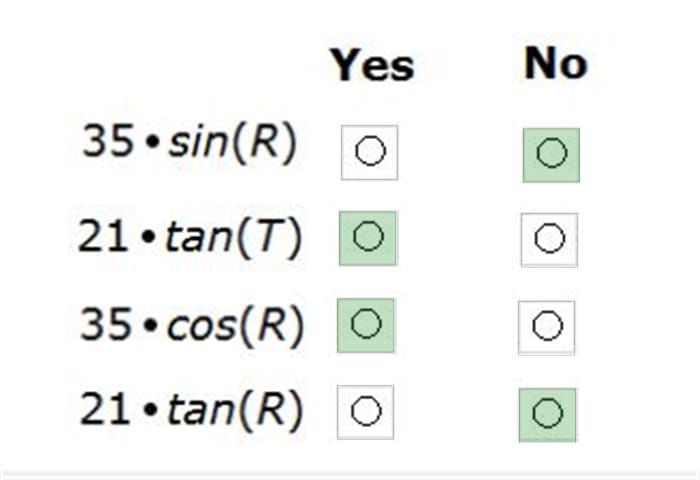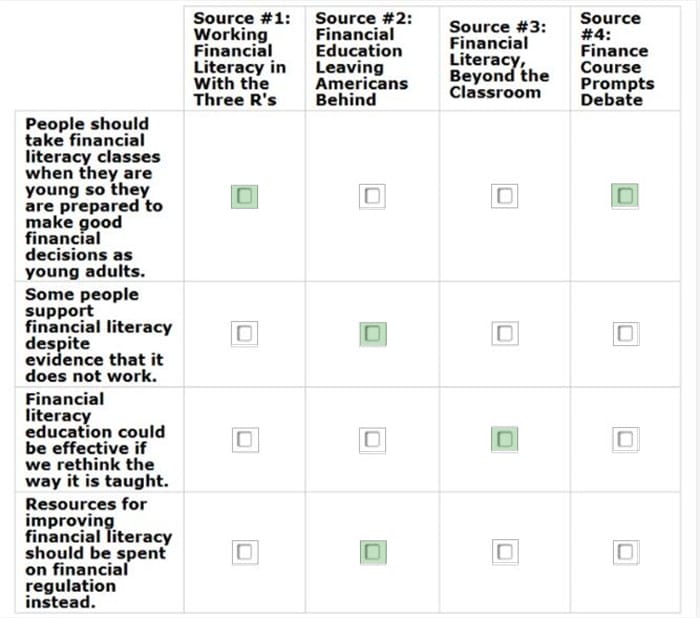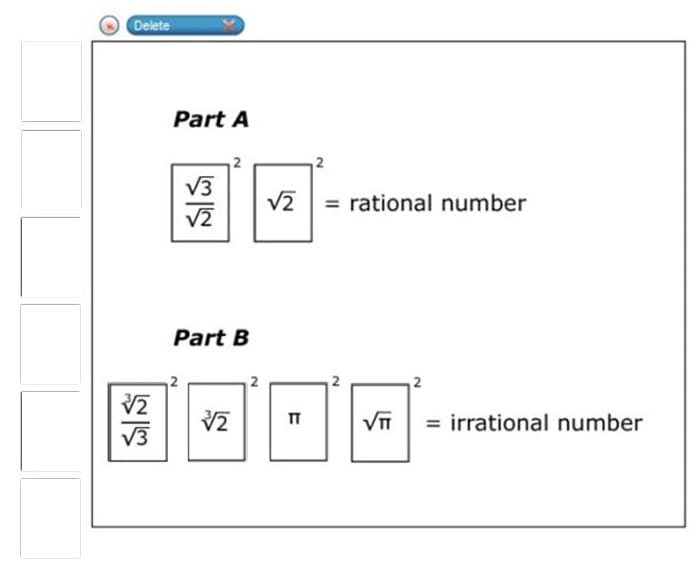Exam Details
Exam Code
:SBACExam Name
:Smarter Balanced Assessment ConsortiumCertification
:Test Prep CertificationsVendor
:Test PrepTotal Questions
:224 Q&AsLast Updated
:Apr 14, 2025
Test Prep Test Prep Certifications SBAC Questions & Answers
-
Question 191:
HOTSPOT
Emma is standing 10 feet away from the base of a tree and tries to measure the angle of elevation to the top. She is unable to get an accurate measurement, but determines that the angle of elevation is between 55 degrees and 75 degrees.
Decide whether each value given in the table is a reasonable estimate for the tree height. Choose Reasonable or Not Reasonable for each height.
Hot Area:
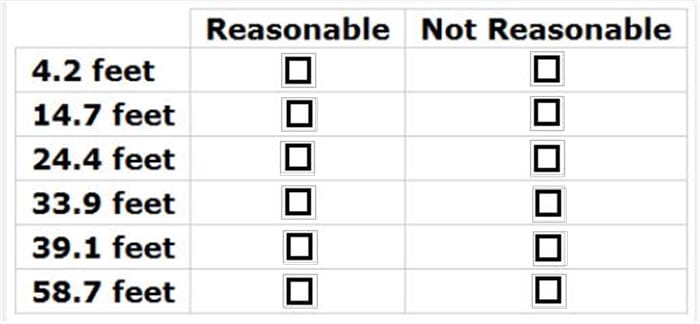
-
Question 192:
HOTSPOT
Consider this right triangle.
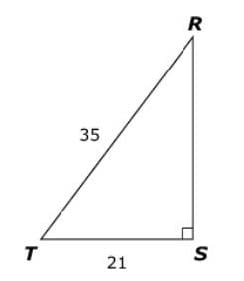
Determine whether each expression can be used to find the length of side RS. Choose Yes or No for each expression.
Hot Area:

-
Question 193:
HOTSPOT A student is writing an argumentative report about the causes of sleepwalking. She found possible sources for her report. Read the sources and the directions that follow. Source 1: “What is Sleepwalking?” by Mat Valerio Sleepwalking is a sleep disorder that causes a person to get up and walk while still asleep, usually during the deepest stages of sleep. While sleepwalking, a person does not often respond when someone asks a question or touches him or
her. Though sometimes a sleepwalker will verbally respond, the response will make no sense. A sleepwalking episode can include the person just walking quietly around a room or demonstrating very agitated behavior and trying to “escape” the room.
Source 2: “Is Sleepwalking Genetic?” by Chris Shue Sleepwalking occurs most often during middle childhood through adolescence. Some adults also sleepwalk, but it is much more common among children. Genetics may play a big role in determining who will be a sleepwalker as the tendency runs in families. Environmental and medical conditions also may contribute to sleepwalking episodes. Sleepwalking was described in some of the earliest recorded medical literature, even before Hippocrates, the “father of medicine,” lived.
Source 3: “Am I a Sleepwalker?” by Angelique Kandar Research has shown that a variety of factors contribute to sleepwalking episodes. Sleepwalkers are usually operating under a severe lack of sleep or have an irregular or hectic sleep schedule. Often, they are under great amounts of stress or
anxiety. Some medical conditions, such as abnormal heart rhythms, nighttime seizures, and sleep apnea, have been known to cause sleepwalking. Sometimes a person who has taken a certain medication experiences a sleepwalking episode. The student wrote down some claims to use in her report. Look at the claims on the table. Determine if the information in the sources supports each claim. Choose the boxes to show the claims that each source supports. A source may have
more than one box chosen.
Hot Area:

-
Question 194:
HOTSPOT
Student Directions
Mandatory Financial Literacy Classes Argumentative Performance Task
Task:
In your economics class, you are discussing the importance of making smart financial decisions. Your teacher tells you that, in some school districts, students are required to take a financial literacy class before graduating. Your school board
is hosting a meeting to decide whether to offer such a course for graduation, and wants students to contribute their perspectives. As part of your initial research, you have found four sources about financial literacy classes.
After you have reviewed these sources, you will answer some questions about them. Briefly scan the sources and the three questions that follow. Then, go back and read the sources carefully so you will have the information you will need to
answer the questions and finalize your research. You may click on the Global Notes button to take notes on the information you find in the sources as you read. You may also use scratch paper to take notes.
In Part 2, you will write an argumentative essay on a topic related to the sources.
Directions for Beginning:
You will now examine several sources. You can re-examine any of the sources as often as you like.
Research Questions:
After looking at the sources, use the rest of the time in Part 1 to answer three questions about them. Your answers to these questions will be scored. Also, your answers will help you think about the information you have read and looked at,
which should help you write your argumentative essay.
You may click on the Global Notes button or refer back to your scratch paper to look at your notes when you think it would be helpful. Answer the questions in the spaces below the items.
Both the Global Notes on the computer and your written notes on scratch paper will be available to you in Part 1 and Part 2 of the performance task.
Part 1
Sources for Performance Task:
Source #1
This article, from April 9, 2010, is from the New York Times, and is about the potential benefits of financial literacy courses.
Working Financial Literacy in With the Three R's by Tara Siegel Bernard
Most Americans aren't fluent in the language of money. Yet we're expected to make big financial decisions as early as our teens– Should I take on thousands of dollars of student debt? Should I buy a car? – even though most of us received
no formal instruction on financial matters until it was too late.
While no course in personal finance could have prevented many Americans from getting caught up in the housing bubble1, it's clear that most of us need some help, preferably starting when we're still in school. And I'm not just talking about learning to balance your checkbook. Its understanding concepts like the time value of money, risk and reward, and, yes, the importance of savings.
All of this raises the question: What's happening inside our classrooms? And how many schools even broach the topic? As it turns out, for a country that prizes personal responsibility, we're doing very little.
"We need to teach the basics of economics and finances so people can make financial decisions in a changing world," said Annamaria Lusardi, economics professor at Dartmouth College and a research associate at the National Bureau of
Economic Research. "It's the compounding of interest2, the problem of inflation3. These are the principles. And these are really scientific topics.”
While more states are beginning to require some sort of personal finance instruction, there aren't enough that do, financial literacy experts say, and there is little consistency in the quality of the education. Just 13 states require students to take a personal finance course or include the subject in an economics course before they graduate from high school, up from seven states in 2007, according to the Council for Economic Education. Meanwhile, 34 states (including those 13) have personal finance within their curriculum guidelines, up from 28 states in 2007…
But that hasn't stopped enterprising teachers like Mathew Frost, who teaches 11th and 12th graders American history and economics at Sunset High School in Dallas, from working the topic into his student's school day. The Texas economics curriculum carves out time for personal finance, but it doesn't test students on the material. Mr. Frost says it's just too important to ignore. So he tries to bring the lesson to life for his students by pairing them up as married couples and giving them a couple of children. The students must then create a budget based on the average income range for their neighborhood, or about $21,000 to $40,000 a year. As in the board game “Life," the students are dealt real-world circumstances. Mr. Frost has them randomly pick "chance cards" from a bag, which might tell them they need new brakes for their car, broke an arm, suffered a death in the family, or found $20.
"I try to make it as realistic as possible," he said. "We talk about building budgets, expenses, investing money," he added, as well as "how to use credit wisely, insurance and careers."
One of his students later wrote about the experience. The 11th grader, who simulated life with a wife and two children on $21,000 a year, told of balancing needs versus wants, trying to find an apartment in a safe neighborhood that fit the
family budget, and the effect of an unexpected rent increase on their savings.
"I first learned that real life isn't going to be as nice as this game," he said. "I also learned that good budgeting has to be maintained throughout a person's life no matter the income, no matter the living conditions."
Research shows that this type of financial education tends to resonate with the students later.
Michael S. Gutter, an assistant professor of family financial management at the University of Florida, studied the issue in 2009, after he surveyed 15,700 students at 15 universities who came from states with different (or nonexistent) personal
finance schooling requirements. The study was financed by the National Endowment for Financial Education, a nonprofit organization in Denver that provides financial education curriculums.
"College students who came from states where there was a course required were more likely to budget, were more likely to be saving, and were less likely to have maxed out their credit cards in the last year and were more likely to be paying
off their credit cards fully," Professor Gutter said. But his research also suggested that "social learning is also very powerful as well," he said. "What your parents tell you matters.”
"It's hard because there is no silver bullet to get this into every school," said Matthew Yale, deputy chief of staff to Education Secretary Arne Duncan. "It's not as simple as saying, ‘We're going to institute this in the 100,000 public schools in
America.’ But our plan for reauthorization does make room for financial literacy in schools, which is a really big, big deal." Mr. Yale was referring to the Obama administration's plan to revise the Elementary and Secondary Education Act,
commonly known as No Child Left Behind. He said the Department of Education's next step is to work with districts and teachers and help them find the money they need, whether it's through the many literacy-minded nonprofits or the private sector. Mr.Yale also said that department officials were working on competitive grant programs, which would allow schools to compete for money to pay for the financial literacy programs. As a joint effort with the Treasury Department, the Education Department is currently running the National Financial Capability Challenge, an online exam for high school students that measures financial know-how and recognizes outstanding performers, to help raise awareness.
President Bush created the first Advisory Council on Financial Literacy in 2008, and President Obama plans to assemble his own team. In its annual report, the first council recommended that Congress or state legislatures mandate financial education in all schools for students in kindergarten through 12th grade. But the new administration follows through with that recommendation? Mr. Yale said education officials were "not interested in introducing unfunded mandates."
So what can we do? According to Scott Truelove, who teaches personal finance as part of a work-study program for seniors at Chesterton High School in Indiana, "It will take a parent movement."
Mr. Truelove has already seen the power of financial education in his school's hallways, where a student told him and another personal finance teacher that she set up a Roth 1.R.A.* given what she learned in class.
"That, to me, is huge," Mr. Truelove said.
1ousing bubble: when housing prices rapidly increase to unsustainable levels and then collapse
2compound interest: interest paid on both the original amount of money invested and on the interest it has already earned 3inflation: a general increase in prices that decrease the purchasing power of money 4“Roth I.R.A.: a type of individual retirement account
Bernard Siegal, Tara. (2010, April 9). Working Financial Literacy in With the Three R's. The New York Times. Retrieved from http://www.nytimes.com/2010/04/10/your-money/10money.html
Source #2
In this article from February 6, 2009, the Chicago Tribune discusses problems with financial literacy education. Financial Education Leaving Americans Behind by Greg Burns
With so many personal finance decisions turning into disasters, a chorus of voices is singing the praises of financial-literacy education.
Make every American a financial whiz, the thinking goes, and credit bubbles never will bedevil us again.
Trouble is, growing evidence suggests that financial-literacy courses don't work. Worse, they may actually hurt, in part by making their graduates overconfident about limited skills.
Few want to hear that message, according to Lauren Willis, a professor at Loyola Law School in Los Angeles, whose recent paper, "Against Financial Literacy
Education,” shook up all sorts of vested interests. . . .
Plenty of people make a living off these courses, and lawmakers love them, since they give the impression that something is being done about the intractable problem of financial ignorance.
Utah, Missouri, and Tennessee require students to take a semester-long personal-finance class before graduating from high school. Illinois and 16 other states incorporate financial education into other subjects–by decree, of course.
The Indiana Senate this month approved a bill that would require "personal financial responsibility" to be taught from kindergarten through high school. Its sponsor described it as an appropriate response to "difficult times." Other states are
mulling expanded mandates
These measures don't affect only youth. Adults face similar obligatory instruction when they seek bankruptcy protection or, in some cases, apply for loans.
Academics have known for years about the scant evidence in support of the programs, but few are willing to go as far as Willis in bluntly denouncing them as a counterproductive racket."
She cites examples, such as the high school students who took a semester-long personal finance course and tested worse than those who didn't. Or the graduates of retirement-planning classes who thought their literacy had increased, when
their financial test scores had not.
Now comes a study from Harvard Business School raising more doubts. Using rigorous methodology, it concluded that programs in widespread use during the past two decades were no use at all.
"They weren't effective in changing people's financial decisions," said Shawn Cole, one of two professors behind the report, titled "If You Are So Smart, Why Aren't You Rich?"
"We find no effect," he said. "My gut feeling is that teaching math or statistics would be more useful."
Still, Cole believes it may be possible to design an effective program. That's a common theme among those who favor financial education: Just because no one has proven these courses work is no reason to give up searching for the right
formula.
Willis has other ideas. She wants to forget about making Americans capable of handling their credit and investment needs – most will never get there, especially given the fast-moving, complicated nature of financial services.
She favors pro-consumer regulation and one-on-one counseling with unbiased advisers. Sure, those could be tough to come by. But no one said saving Americans from themselves would be easy.
1racket: a dishonest scheme or business activity
Burns, Greg. (2009, February 6). Financial Education Leaving Americans Behind. Chicago Tribune. Retrieved from http://articles.chicagotribune.com/2009-02-16/news/0902150143_1_financial-literacy-financial-literacy-education-financial
ignorance.
Source #3 This October 6, 2013 article from the New York Times is about the drawbacks of financial literacy courses, and what the research shows about teaching financial literacy skills. Financial Literacy, Beyond the Classroom
by Richard H. Thaler
Even if we grade on a very generous curve, many Americans flunk when it comes to financial literacy. Consider this three-item quiz:
Suppose you had $100 in a savings account and the interest rate was 2 percent a year. After five years, how much do you think you would have if you left the money to grow? More than $102, exactly $102 or less than $102?
Imagine that the interest rate on your savings account was 1 percent a year and that inflation was 2 percent. After one year, would you be able to buy more than, the same as, or less than you could today with the money?
Do you think this statement is true or false: "Buying a single company stock usually provides a safer return than a stock mutual fund"?
Anyone with even a basic understanding of compound interest, inflation and the answers to these questions are "than" and "false." Yet in a survey of Americans over age 50 conducted by the economists Annamaria Lusardi of George
Washington University and Olivia S Mitchell of the Wharton School of the University of Pennsylvania, only a third could answer all three questions correctly.
This is particularly troubling given the inherent complexity of our modern economy. Whether in taking out a student loan, buying a house, or saving for retirement, people are being asked to make decisions that are difficult even if they have
graduate training in finance and economics. Throwing the financially illiterate into that maelstrom is like taking students currently enrolled in driver's education and asking them to compete in the Indianapolis 500.
A popular approach to this problem is to work harder to improve financial literacy – for example, by including household finance in the basic high school curriculum. One reason to think this solution will have big payoffs is that people who are
more knowledgeable about financial matters, as measured by a test, perform better at tasks like saving for retirement and staying out of debt. This may seem a straightforward argument in support of financial literacy courses. Unfortunately, it
isn't.
The problem is that measured financial literacy is highly correlated with other factors, most notably higher education in general, so it's hard to sort out causes. (The ability to solve the Sunday crossword puzzle is probably also positively correlated with good financial outcomes.) So to see whether a financial education curriculum is likely to pay dividends, we should review specific efforts to shore up financial skills in those who are deficient, and not just measure what people already know.
A new paper by three business school professors – Daniel Fernandes of Erasmus University in the Netherlands and the Catholic University of Portugal, John G. Lynch Jr. of the University of Colorado, and Richard Netemeyer of the University of Virginia – presents a discouraging assessment of attempts to teach people how to deal with money. Their article uses a technique called meta-analysis,” looking at results from 168 scientific studies of efforts to teach people to be financially astute, or at least less clueless.
The authors’ conclusions are clear: over all, financial education is laudable,* but not particularly helpful. Those who receive it do not perform noticeably better when it comes to saving more, for example, or avoiding ruinous debt. . . .
Don't get me wrong. I am all for trying to teach household finance in schools, starting as early as possible. And when it comes to high school, I think learning about compound interest is at least as important as trigonometry or memorizing the
names of all 50 state capitals. If we try enough approaches, and evaluate what works, we may improve such programs' effectiveness. But we shouldn't fool ourselves into thinking that adding a household finance class to a high school
curriculum will in itself create knowledgeable consumers who can understand today's wide array of financial products.
…In the meta-analysis, even the most time-intensive programs – those with more than 24 hours of education and training, almost the length of a college course – had no discernible effects just two years later.
It would be premature to conclude that all efforts at improving financial literacy are futile. But it is a fair conclusion that simply doing more of the training commonly used now will not produce significant results. So what else might we try?
Although no approach offers a panacea,” three types of efforts seem worthy of more attention.
The first is what Professor Lynch, one of the authors of the meta-analysis, calls just-in-time education.
Because learning decays quickly, it's best to provide assistance just before a decision is made. High school seniors should receive help in how to think about a student loan and how to make sure that the education bought with the loan offers
good prospects for repayment. Just-in-time education can be offered at other crucial moments–when taking out a mortgage or figuring out when to retire. But unless such education is compulsory, many of the consumers most in need of help
don't take advantage of it. And we need to be sure not to confuse self-serving marketing5 with objective advice.
Another approach is to offer simple rules of thumb to help people cope. Because few people can calculate how much they need to save for a comfortable retirement, it might help to offer simple guidelines like “invest as much as possible in
your 401(k) plan, H6 “save 15 percent of your income," or "get a 15-year mortgage if you are over 50."
One example comes from a field experiment involving microentrepreneurs7 in the Dominican Republic. Of those who expressed an interest in receiving help, some were offered training in basic accounting principles while others were given
simple rules of thumb. The accounting education did not have apparent effects, but simple rules – like keeping personal money and business money in separate drawers – led to better outcomes. This seemingly trivial concept helped small-
business owners keep better track of how their businesses were faring.
The third approach, and the one I believe offers the best prospects of immediate help, is to make our financial system more user-friendly. You don't need to be a computer scientist to use a smartphone. If we made choosing a suitable
mortgage as easy as checking the weather in Timbuktu, fewer households would find themselves underwater* when real estate markets tumble…
The same principle can be used in other areas, from credit cards to checking accounts. The financial services industry – either on its own or as required by government regulators – needs to find ways to make it easier for people to make
sound decisions. And those financial firms that engage in fraudulent practices should be prosecuted and stopped.
1diversification: investing in different assets in order to minimize risk
2meta-analysis: an analysis of several separate but similar studies to determine if an observed effect is not due to chance alone
3laudable: praiseworthy
4panacea: a solution or remedy for all difficulties or diseases
5self-serving marketing: surveys, top 10 lists, and technical papers that contain seemingly useful consumer information but are being used as a marketing strategy
6401(k) plan: a retirement savings plan in which deductions are automatically made from an employee's paycheck before taxes are deducted and that are sometimes matched by the employer
7microentrepreneur: operator of a microenterprise, or very small business; microenterprises typically employ fewer than ten people and have relatively low start-up costs
8 underwater: when an individual owes more on a loan than the market value of the loan; this term is typically applied to home mortgages
Thaler, Richard H. (2013, October 6). Financial Literacy, Beyond the Classroom. New York Times. Retrieved from http://www.nytimes.com/2013/10/06/business/financial-literacy-beyond-the-classroom.html.
Source #4
This article, from October 15, 2006, is from the Baltimore Sun and is about concerns surrounding mandated financial literacy classes.
Finance Course Prompts Debate
by Gina Davis
While Carroll County students will be required to take a financial literacy course to graduate starting next year, concerns linger over whether mandating the course is the most effective way to teach money matters to teens.
"The course is likely a good thing, but I am convinced it is not the best thing," school board President Thomas G. Hiltz said last week. "One course is not a panacea and, alone, will not make our students financially literate."
After a lengthy debate about requiring the class, board members voted 4-1 to require students beginning next school year to take the half-credit course. It will cover concepts such as money management, consumer rights and responsibilities,
credit, savings, and investing.
Carroll joins a handful of Maryland school systems – including Harford, St. Mary's, Talbot and Baltimore counties–with a similar requirement.
The financial course was one of several changes to the high school program of studies that the board approved.
During last week's meeting, Hiltz joined Cynthia L. Foley in supporting a motion to amend the proposal that would have eliminated financial literacy as a required course. The motion to amend failed in a 3-2 vote.
Foley was the lone dissenter1 when the original proposal came to a vote. Hiltz said he voted to approve the high school program of studies that included the financial literacy requirement because he supported the overall plan.
“While it did not turn out the way I may have wanted... unless I believe there has been an egregious mistake in judgment, a vote against the entire high school program of studies is, in my view, sour grapes," Hiltz said in an email.
During the meeting, Hiltz suggested the board needed more time to consider alternatives, such as incorporating elements of the course into already required classes or developing a comprehensive “financial literacy program," not a single
course.
Hiltz also said a required course would necessitate about 10 teachers each year and cost the system about $600,000 annually.
"My overwhelming concern is not cost – it is effectiveness," Hiltz said. "The $600,000 is a low cost if the course is effective. An effective course will return that investment. It is a high cost if it is ineffective."
School officials said statistics suggest teens and young adults are assuming too much credit card debt and are not knowledgeable about finances.
About one in five students gets a personal finance course during high school, according to the JumpStart Coalition for Personal Financial Literacy, which surveys high school seniors every other year to gauge financial aptitude.
Of the 5,775 high school seniors in 37 states who participated in that survey this year, students on average scored 52.4 percent on 30 questions, according to the group.
A 2004 poll of college administrators found that excessive credit card debt was the primary reason students dropped out and the secondary reason was low grades, according to the Maryland Coalition for Financial Literacy.
Carroll school officials said last week that in a "pre-test" given to about 30 students taking the
financial literacy elective this semester, the highest score was about 60 percent–with some students scoring much lower.
"Personal finances are not being taught in the home," said Patricia Hummel, a parent who also teaches financial literacy at Winters Mill High as a permanent substitute. "Studies have shown that only 26 percent of 13- to 21-year-olds reported
that their parents actively taught them how to manage money.”
Hummel supported a required financial literacy course because, "unless this class is mandated, students will not take advantage of the class."
Hiltz said that while the district has piloted [tested] a financial literacy course; no local data has been collected on its effectiveness.
"We all agree that financial literacy is essential," he said. "The lack of a real consideration of other options … troubled me greatly. I am concerned that we picked low-hanging fruit, which may be the most expensive and least effective option.”
1dissenter: someone who disagrees with a particular view
Davis, Gina. (2006, October 15). Finance Course Prompts Debate. Baltimore Sun. Retrieved from http://articales.baltimoresun.com/2006-10-15/news/0610140104_1_hiltz-high-school-program-financial-literacy.
Click on the boxes to show the claim(s) that each source supports. Some supports will have more than one box selected.
Hot Area:
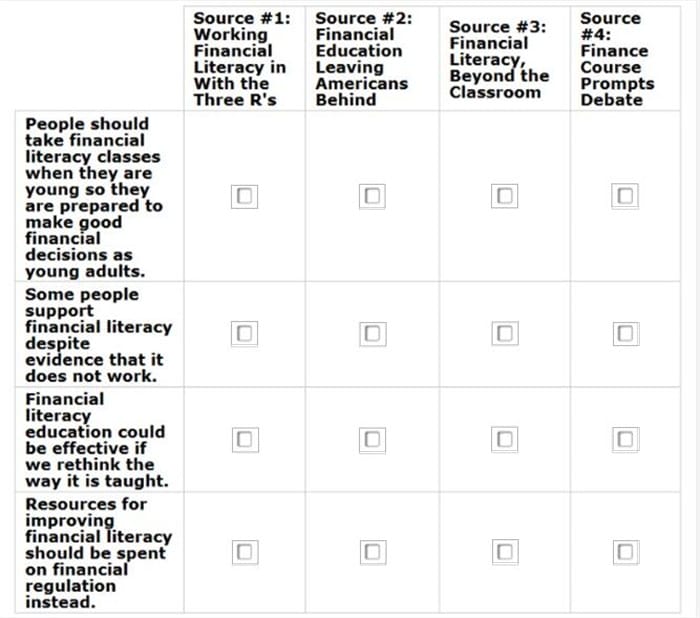
-
Question 195:
DRAG DROP
Cheryl claims that any irrational number squared will result in a rational number.
Part A
Drag an irrational number into the first response box that when squared will result in a rational number.
Part B
Drag an irrational number into the second response box that when squared will result in an irrational number.
Select and Place:
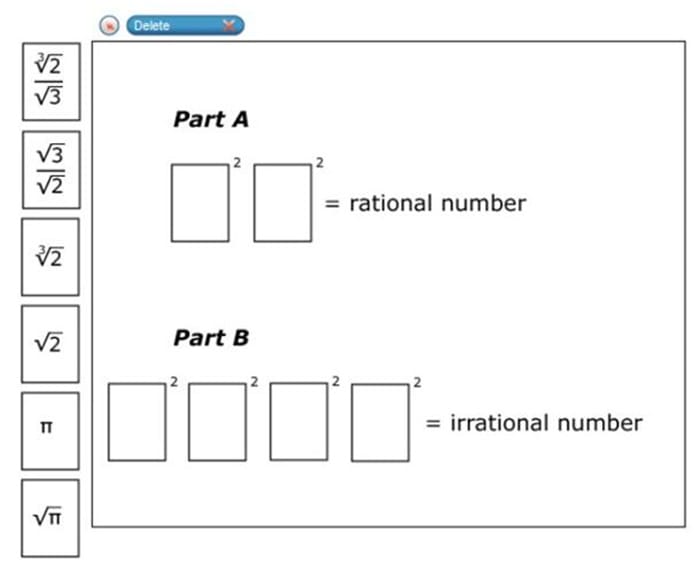
-
Question 196:
FILL BLANK
Case study
Lights, Candles, Action!
Your friend Abbie is making a movie. She is filming a fancy dinner scene and she has two types of candles on the table. She wants to determine how long the candles will last.
She takes a picture, lights the candles, and then lets them burn for 1 hour. She then takes a second picture. You can assume that each candle burns at its won constant rate.
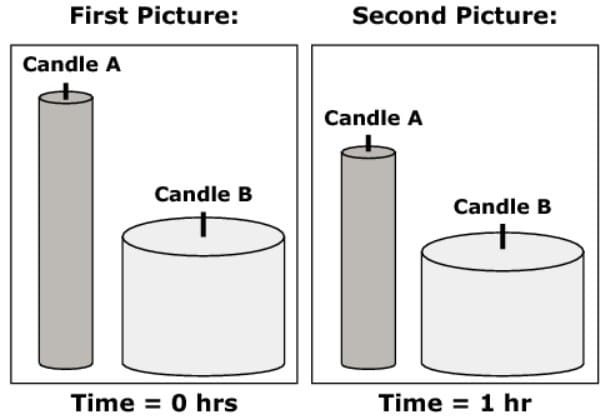
Candle Type A initial height = 20 cm
Candle Type B initial height = 10 cm Candle Type A height after burning for 1 hour = 16 cm Candle Type B height after burning for 1 hour = 9 cm
You will use this information to help Abbie think about the candles she might use for her film.
Candles A and B are lit at the same time. What will be the height, in cm, of each candle after 3 hours of burning?
Candle Type A:
Candle Type B:
A.
See explanation below.
-
Question 197:
FILL BLANK
Case study
Lights, Candles, Action!
Your friend Abbie is making a movie. She is filming a fancy dinner scene and she has two types of candles on the table. She wants to determine how long the candles will last.
She takes a picture, lights the candles, and then lets them burn for 1 hour. She then takes a second picture. You can assume that each candle burns at its won constant rate.

Candle Type A initial height = 20 cm
Candle Type B initial height = 10 cm Candle Type A height after burning for 1 hour = 16 cm Candle Type B height after burning for 1 hour = 9 cm
You will use this information to help Abbie think about the candles she might use for her film.
Candles of each type were lit at the same time. Abbie thinks that since Candle Type A burns more quickly than Candle Type B, that it will burn out (have a height of 0cm) first.
Julie thinks that since Candle Type B starts out much shorter than Candle Type A, it will be the candle to burn out first.
Which candle will burn out first? Give a mathematical explanation to convince Abbie and Julie of your solution. Clearly identify the quantities involved.
A.
See explanation below.
-
Question 198:
FILL BLANK
Case study
Lights, Candles, Action!
Your friend Abbie is making a movie. She is filming a fancy dinner scene and she has two types of candles on the table. She wants to determine how long the candles will last.
She takes a picture, lights the candles, and then lets them burn for 1 hour. She then takes a second picture. You can assume that each candle burns at its won constant rate.

Candle Type A initial height = 20 cm
Candle Type B initial height = 10 cm Candle Type A height after burning for 1 hour = 16 cm Candle Type B height after burning for 1 hour = 9 cm
You will use this information to help Abbie think about the candles she might use for her film.
Abbie has 3 hours left to film. She lights a new Candle Type A and Candle Type B and then starts filming.
In the 3 hours she has left, will Abbie capture the moment when the candles are exactly the same height?
Explain to Abbie how you can determine the answer.
A.
See explanation below.
-
Question 199:
FILL BLANK
Case study
Lights, Candles, Action!
Your friend Abbie is making a movie. She is filming a fancy dinner scene and she has two types of candles on the table. She wants to determine how long the candles will last.
She takes a picture, lights the candles, and then lets them burn for 1 hour. She then takes a second picture. You can assume that each candle burns at its won constant rate.

Candle Type A initial height = 20 cm
Candle Type B initial height = 10 cm Candle Type A height after burning for 1 hour = 16 cm Candle Type B height after burning for 1 hour = 9 cm
You will use this information to help Abbie think about the candles she might use for her film.
You have decided to use functions to help Abbie think about the candles.
You show her how to represent the height of a candle, h, as a function of time, t, using this equation:
h = k+ nt
First, explain to Abbie what k and n represent in order to model the different candles. Be specific in your explanation.
A.
See explanation below.
-
Question 200:
FILL BLANK
Case study
Lights, Candles, Action!
Your friend Abbie is making a movie. She is filming a fancy dinner scene and she has two types of candles on the table. She wants to determine how long the candles will last.
She takes a picture, lights the candles, and then lets them burn for 1 hour. She then takes a second picture. You can assume that each candle burns at its won constant rate.

Candle Type A initial height = 20 cm
Candle Type B initial height = 10 cm
Candle Type A height after burning for 1 hour = 16 cm
Candle Type B heignt after burning for 1 hour = 9 cm
You will use this information to help Abbie think about the candles she might use for her film.
t hours after it is lit.
Now, choose either Candle A or Candle B to create an equation that will tell Abbie the height of the candle at
Determine what the numerical values for k and n should be for the candle you chose.
Using these k and n values, write an equation that tells Abbie the height h of the candle, in cm, at t hours after it is lit.
A.
See explanation below.
Related Exams:
AACD
American Academy of Cosmetic DentistryACLS
Advanced Cardiac Life SupportASSET
ASSET Short Placement Tests Developed by ACTASSET-TEST
ASSET Short Placement Tests Developed by ACTBUSINESS-ENVIRONMENT-AND-CONCEPTS
Certified Public Accountant (Business Environment amd Concepts)CBEST-SECTION-1
California Basic Educational Skills Test - MathCBEST-SECTION-2
California Basic Educational Skills Test - ReadingCCE-CCC
Certified Cost Consultant / Cost Engineer (AACE International)CGFM
Certified Government Financial ManagerCGFNS
Commission on Graduates of Foreign Nursing Schools
Tips on How to Prepare for the Exams
Nowadays, the certification exams become more and more important and required by more and more enterprises when applying for a job. But how to prepare for the exam effectively? How to prepare for the exam in a short time with less efforts? How to get a ideal result and how to find the most reliable resources? Here on Vcedump.com, you will find all the answers. Vcedump.com provide not only Test Prep exam questions, answers and explanations but also complete assistance on your exam preparation and certification application. If you are confused on your SBAC exam preparations and Test Prep certification application, do not hesitate to visit our Vcedump.com to find your solutions here.
